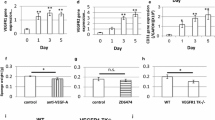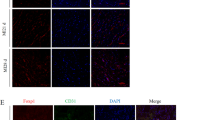Abstract
Heparin-binding epidermal growth factor-like growth factor (HB-EGF) is mitogenic and chemotactic for many cell types. HB-EGF is induced in pathological states which require cell mitogenesis and proliferation, including angiogenesis, and has been reported to interact functionally with basic fibroblast growth factor (bFGF). To test our hypothesis that HB-EGF mRNA expression is increased in myocardial infarction, we used Northern hybridization in rats to investigate the expression of HB-EGF and EGF receptor mRNAs expression in the infarct zone compared to the expression of bFGF and FGF receptor mRNAs. We also performed in situ hybridization to identify the cells responsible for HB-EGF mRNA production. HB-EGF mRNA rapidly increased after ligation (mean ± SE, 5.6 ± 0.23-fold increase at 6 hours compared to the preligation heart levels) and reached a maximum level (9.1 ± 0.42-fold increase) around 12 hours. HB-EGF mRNA then gradually decreased on day 1 (5.8 ± 1.0-fold increase), day 2 (3.2 ± 0.94-fold increase) and day 3 (1.9 ± 0.33-fold increase) after ligation. Parallel changes in bFGF mRNA expression were observed (6, 12 hours, days 1, 2 and 3; 3.6 ± 0.42-, 5.3 ± 0.12-, 2.3 ± 0.12-, 1.7 ± 0.03- and 0.95 ± 0.03-fold increase, respectively). EGF receptor (ErbB-1) mRNA was gradually increased on day 2 (2.4 ± 0.53-fold increase), day 7(4.0 ± 0.61-fold increase) and day 14 (7.0 ± 0.61-fold increase). Similarly, FGF receptor (FGF receptor-1) mRNA was gradually increased (days 2, 7 and 14; 1.3 ± 0.13-, 1.5 ± 0.17- and 2.3 ± 0.15-fold increase, respectively). Reperfusion after a 2-hour ligation (too late to salvage myocytes) enhanced HB-EGF (12 hours, 16.8 ± 1.8-fold increase) and bFGF (12 hours, 10.4 ± 1.1-fold increase) mRNA expression. The cells responsible for the increased production of HB-EGF mRNA were shown by in situ hybridization to be surviving myocytes located in the infarct peripheral zone around infarct necrotizing tissue. In conclusion, our results demonstrated a rapid increase in HB-EGF mRNA expression concomitant with an increase in bFGF mRNA expression, suggesting that HB-EGF and bFGF might play some role in the course of pathological changes in the infarct in the early inflammatory phase. Reperfusion at times too late to salvage myocytes accelerated sequential changes in the expression of both HB-EGF and bFGF mRNAs.
Similar content being viewed by others
Author information
Authors and Affiliations
Additional information
Received: 16 March 2001, Returned for 1. revision: 23 April 2001, 1. Revision received: 31 July 2001, Returned for 2. revision: 22 August 2001, 2. Revision received: 4 September 2001, Accepted: 6 September 2001
Rights and permissions
About this article
Cite this article
Iwabu, A., Murakami, T., Kusachi, S. et al. Concomitant expression of heparin-binding epidermal growth factor-like growth factor mRNA and basic fibroblast growth factor mRNA in myocardial infarction in rats. Basic Res Cardiol 97, 214–222 (2002). https://doi.org/10.1007/s003950200014
Issue Date:
DOI: https://doi.org/10.1007/s003950200014




